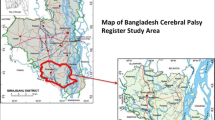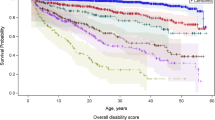Abstract
Children with cerebral palsy (CP) and their families often make strong demands on diagnostic, therapeutic, technical and social facilities. Prevalence estimates are needed to improve treatment and services. As recent Dutch data are not available, the present study aimed to assess the population prevalence of CP in the Netherlands. A representative Dutch area with 1.2 million inhabitants of which 172,000 were born between 1977 and 1988 was studied. To ascertain the children with CP from these birth years, medical practices (such as rehabilitation centres, paediatric and child neurological departments) were consecutively asked to contact their (supposed) CP cases. Next, a parents' organisation and finally regional news media assisted in the ascertainment. In total, 170 ‘supposed’ CP cases underwent an expert examination. Of these 170, 127 children proved to be definite CP-cases, yielding a ‘crude’ average prevalence of 0.74 per 1000 inhabitants (95% CI: 0.61–0.87). Under-ascertainment was recognised and quantified. Accordingly, the population prevalence of CP over the birth year period 1977–1988 was calculated as 1.51 per 1000 inhabitants (average over the 12 birth years). The calculated CP prevalence rose significantly over time: from 0.77 (1977–1979) to 2.44 (1986–1988). This trend is in accordance with other studies.
Similar content being viewed by others
References
Kägeloh-Mann I, Hagberg G, Meisner C, et al. Bilateral spastic cerebral palsy – a comparative study between south-west Germany and western Sweden. I: Clinical patterns and disabilities. Dev Med Child Neurol 1993; 35: 1037–1047.
Mutch L, Alberman E, Hagberg B, Kodama K, Perat MV. Cerebral palsy epidemiology: Where are we now and where are we going? (see comments). Dev Med Child Neurol 1992; 34: 547–551.
Krägeloh-Mann I, Hagberg G, Meisner C, et al. Bilateral spastic cerebral palsy – a collaborative study between south-west Germany and western Sweden. III: Aetiology (see comments). Dev Med Child Neurol 1995; 37: 191–203.
Hagberg B, Hagberg G, Olow I, von Wendt L. The changing panorama of cerebral palsy in Sweden. V. The birth year period 1979–82. Acta Paediatr Scand 1989; 78: 283–290.
Hagberg B, Hagberg G, Olow I. The changing panorama of cerebral palsy in Sweden. VI. Prevalence and origin during the birth year period 1983–1986. Acta Paediatr Scand 1993; 82: 387–393.
Hagberg B, Hagberg G. The changing panorama of cerebral palsy – bilateral spastic forms in particular. Acta Paediatr Scand 1996; 416 (Suppl. October): 48–52.
Krägeloh-Mann I, Hagberg G, Meisner C, et al. Bilateral spastic cerebral palsy – a comparative study between south-west Germany and western Sweden. II: Epidemiology. Dev Med Child Neurol 1994; 36: 473–483.
Meberg A, Broch H. A changing pattern of cerebral palsy. Declining trend for incidence of cerebral palsy in the 20-year period 1970–89. J Perinat Med 1995; 23: 395–402.
Pharoah PO, Cooke T, Cooke RW, Rosenbloom L. Birthweight specific trends in cerebral palsy. Arch Dis Child 1990; 65: 602–606.
Topp M, Uldall P, Langhoff-Roos J. Trend in cerebral palsy birth prevalence in eastern Denmark: Birth-year period 1979–86. Paediatr perinat Epidemiol 1997; 11: 451–460.
Murphy CC, Yeargin-Allsopp M, Decoufie P, Drews CD. Prevalence of cerebral palsy among ten-year-old children in metropolitan Atlanta, 1985 through 1987. J Pediatr 1993; 123(5): 13–20.
Stanley FJ, Blair E, Alberman E. How common are the cerebral palsies? In: Stanley FJ, Blair E and Alberman E (eds) Cerebral Palsies: Epidemiology and Causal Pathways, London: MacKeith Press, 2000, Chap. 4, pp. 22–39 (and table on pp. 208–209) ISBN1-898683-20.
Vries JS de. Encephalopathia infantilis, PhD Thesis. Utrecht University, Utrecht, 1967.
Phelps Foundation for the Spastics, Zorg voor de spastische patiënt vandaag en morgen. Onderzoek naar het aantal spastici in Nederland (Report: Inquiry into the number of spastic persons in the Netherlands) 1982, Bussum, The Netherlands.
Centraal Bureau Statistiek CBS. Gelderland: groot en gemiddeld (Gelderland: large and average). Index; facts and figures on our society 1998; 5: 22–23. Rijswijk, The Netherlands.
Bax MCO. Terminology and classi.cation of cerebral palsy. Dev Med Child Neurol 1964; 6: 295–307.
MacKeith RC, MacKenzie ICK, Polani PE. The Little Club; memorandum on terminology and classification of ‘cerebral palsy’. Cereb Palsy Bull 1959; 1: 27–35.
Nelson KB, Ellenberg JH. Children who ‘outgrew’ cerebral palsy, Pediatrics 1982; 69: 529–536.
Rumeau-Rouquette, C. Motor disability in children in three birth cohorts. Int J Epidemiol 1992; 21: 359–366.
Parkes J, Dolk H, Hill N. The Northern Ireland Cerebral Palsy Research Project. 1997 Report. Belfast: Queen's University, 1998.
Author information
Authors and Affiliations
Rights and permissions
About this article
Cite this article
Wichers, M., van der Schouw, Y., Moons, K. et al. Prevalence of cerebral palsy in The Netherlands (1977–1988). Eur J Epidemiol 17, 527–532 (2001). https://doi.org/10.1023/A:1014515520670
Issue Date:
DOI: https://doi.org/10.1023/A:1014515520670




